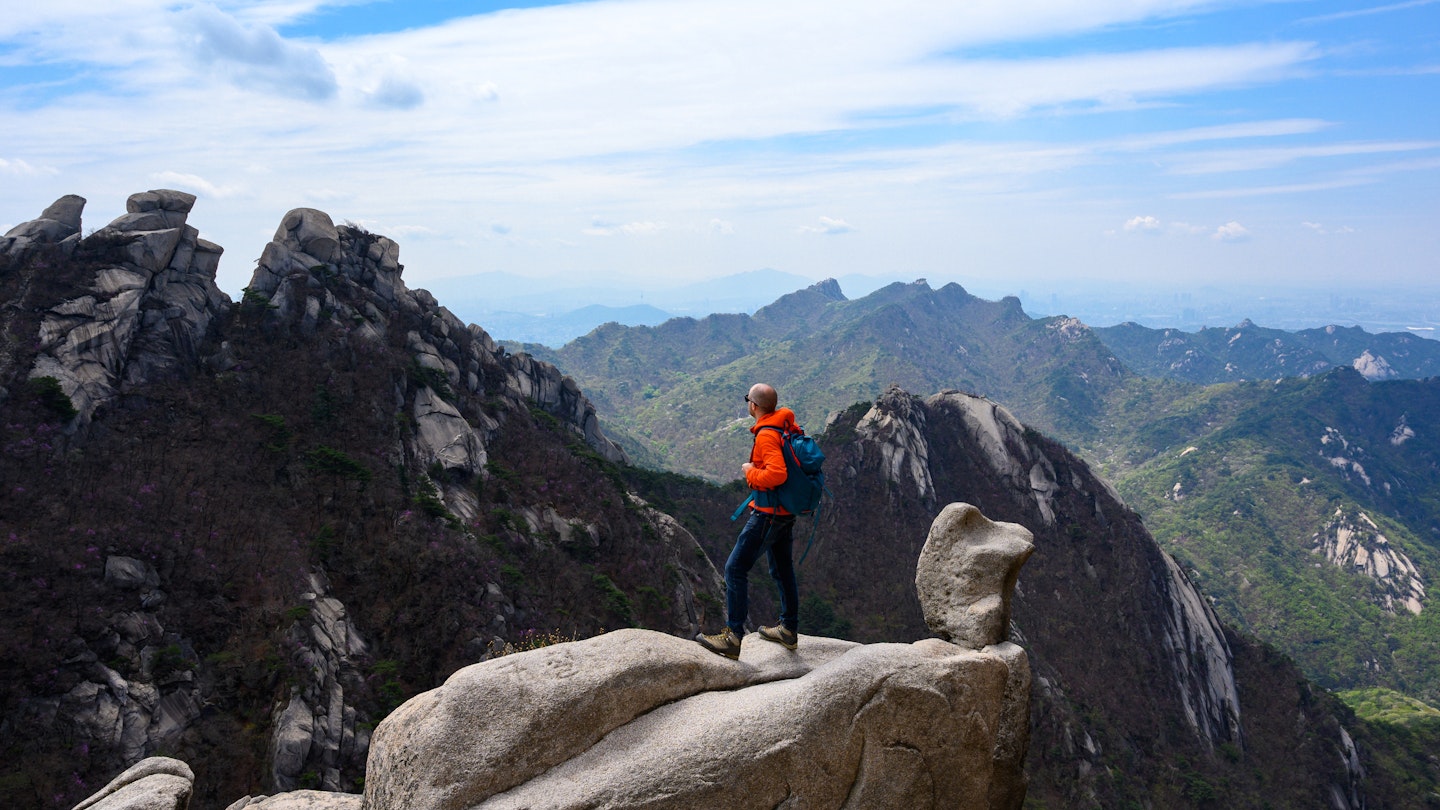Discover the Best Hiking Trails in South Korea with GoTravelDaily
Roughly 70% of the Korean peninsula is covered in mountains, making hiking one of the country’s national pastimes.
Koreans take this pursuit seriously, joining hiking clubs and investing in quality gear. However, novices also have ample opportunities to participate. Many trails require no more than a decent pair of sneakers, and not all treks involve climbing daunting peaks. You can find relaxing seaside walks and captivating urban paths as well.
More than just a workout, hiking in Korea allows you to explore the country’s history, including mountain myths and remote Buddhist temples, alongside stunning natural features like volcanic tuff cones and vibrant autumn foliage. Best of all, it’s a vibrant way to socialize with local residents in their natural habitat: on the trail.
Hallasan Mountain Seongpanak Trail
Best hike for peak baggers and volcanophiles
9.6km (6 miles) one way, 4.5 hours, moderate
Locally renowned, “Jeju is Hallasan, and Hallasan is Jeju,” captures the essence of this majestic mountain, standing at 1947m (6388ft) and dominating the island of Jeju-do. Hallasan is not only South Korea’s tallest peak but also culturally significant to Koreans.
The Seongpanak Trail on the eastern flank is the preferred route, beginning from the Hallasan National Park Visitor Information Center. The first segment features a path of black volcanic stones amidst a gotjawal forest, creating a primordial atmosphere. A worthy 40-minute detour at around 5.6km leads to Sara Oreum, a parasitic volcano cone with a small crater lake atop.
As you reach the Jindallae-pat (Azalea Field) Shelter, the trail steepens for the final 2.3km (1.4 miles) to the summit, where high winds and potential winter snow require appropriate clothing. Nevertheless, the ascent presents no technical challenges and includes staircases. Upon reaching the summit, you’ll enjoy panoramic views of Baengnokdam, a 400m (1,312ft) wide caldera that occasionally houses a crater lake.

Daecheongbong Peak Course
Best hike for dramatic scenery and sunrises
16km (10 miles) one way, 12 hours, challenging
Seoraksan National Park is arguably Korea’s most breathtaking landscape, complete with soaring granite peaks, secluded valleys, and majestic waterfalls. The Daecheongbong Peak Course showcases many highlights, featuring the park’s tallest peak, Daecheongbong at 1708m (5604ft).
The hike initiates near the Seoraksan Cable Car in Seorak-dong, where you can energize before hitting the trail. Early segments are leisurely, leading to Biseondae Rock, where a Taoist hermit allegedly ascended to heaven. Cheonbuldong Valley dazzles particularly in October, showcasing vibrant fall colors. Keep an eye out for wildlife like goral and musk deer.
As you progress, you’ll encounter Oryeon Falls and Cheondang Falls before ascending Muneomi Pass. A spring near Huiungak Shelter is your final opportunity to refill before the steep hour and 45-minute trek to Daecheongbong. Once reached, you will be greeted with breathtaking views of mountain peaks and the shimmering East Sea below.
Many Korean hikers time their ascent to witness the sunrise, making it essential to prepare and plan to stay overnight in a shelter for a stunning early start.
Jongju (Traversing) Course in Jirisan
Best hike for adventure and fall foliage
25.5km (15.8 miles) one way, 3 days, challenging
Jirisan, meaning “mountain of the odd and the wise,” offers a transformative experience for those who venture into its wild terrains. This classic three-day trek spans the ridgeline from west to east, beginning at the Jirisan National Park Ranger Station at Seongsamjae.
Some hikers prefer to intensify their journey by starting from Hwaeom-sa temple, known for its national treasures. An hour and a half past Nogodan, you’ll find Piagol Valley, celebrated for its vibrant crimson maple leaves in the fall. This out-and-back hike takes about 10 hours, but even a brief diversion through the valley is worthwhile.
Throughout the trek, keep your eyes peeled for an abundance of flora and fauna, encountering hares, elk, and Asiatic black bears. After completing the trek, share your experiences and photos with fellow hikers!

Jeju Olle Trail Route 10-1
Best accessible hike
4.2km (2.6 miles) one way, 2 hours, easy
Located just 2.25km off the southwestern tip of Jeju-do, Gapa-do is a small, flat island that makes hiking accessible. The trail begins at Sangdong-pogu Port after a quick ferry ride.
This trail offers an immersive cultural experience as you pass traditional locations and charming eateries serving local delicacies like abalone porridge. The path leads you around the island for magnificent views of Marado to the south and Hallasan to the north.
Keep an eye out for Jeju’s famed female divers, the haenyeo, as you journey along the coast back to Hadong Village.
Seoul City Wall
Best hike for urban exploration
18.6km (11.5 miles) round trip, 12 hours, easy to moderate
If you’re tight on time, circumnavigating the historic Seoul city wall offers a fantastic urban hiking experience. The route consists of six segments crossing four guardian mountains and is a great way to discover the vibrant capital.
Starting at Sungnyemun (Namdaemun), you’ll encounter historical sites while enjoying the evolving city landscape. The climb includes the panoramic views of Gyeongbokgung Palace and buzzing neighborhoods filled with local shops and cafes.
Make sure to explore the various segments, each offering unique urban and historical contexts that showcase Seoul’s rich history.





